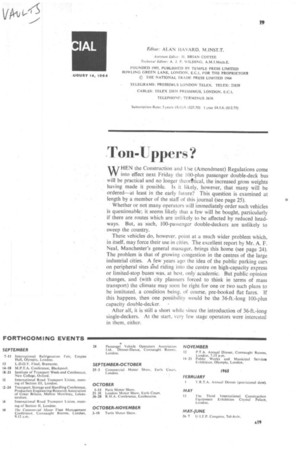Ton-Uppers?
Page 21

If you've noticed an error in this article please click here to report it so we can fix it.
WHEN the Construction and Use (Amendment) Regulations come into effect next Friday the 100-plus passenger double-deck bus will be practical and no longer theorttical, the increased gross weights having made it possible. Is it likely, however, that many will be ordered—at least in the early future? This question is examined at length by a member of the staff of this journal (see page 25).
Whether or not many operators will immediately order such vehicles is questionable; it seems likely that a few will be bought, particularly if there are routes which are unlikely to be affected by reduced headways. But, as such, 100-passenger double-deckers are unlikely to sweep the country.
These vehicles do, however, point at a much wider problem which, in itself, may force their use in cities. The excellent report by Mr. A. F. Neal, Manchester's general manager, brings this home (see page 24). The problem is that of growing congestion in the centres of the large industrial cities. A few years ago the idea of the public parking cars on peripheral sites and riding into the centre on high-capacity express or limited-stop buses was, at best, only academic. But public opinion changes, and (with city planners forced to think in terms of mass transport) the climate may soon be right for one or two such plans to be instituted, a condition being, of course, pre-booked flat fares. If this happens, then one possibility would be the 36-ft.-long 100-plus capacity double-decker.
After all, it is still a short while since the introduction of 36-ft.-long single-deckers. At the start, very few stage operators were interested in them, either.




















































































































